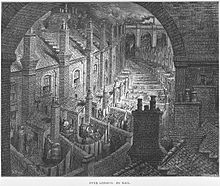Working Conditions
As the coal industry expanded, more and more miners went underground to extract coal and often worked very long hours in hazardous conditions.In 1842 a Parliamentary Committee which reported on the mines found that many workers were working in the most appalling conditions. Not only did they work very long hours, but they were also hired at very young ages. Children as young as five were used as ‘trappers’ to open and close underground doors in the mine to let the ‘hurriers’, who pulled the loaded wagons, get through. These children worked in the dark because their families were often too poor to be able to afford candles. They were in the dark for up to twelve hours each day and often had rats scurrying all over them. If they fell asleep they were beaten by the miners.
The commission also found that children were employed as coal ‘hurriers’, pulling carts or sledges filled with coal over long distances and through very small tunnels. Girls as young as thirteen were often used fir this work. The chain around their waist caused damage to their pelvic bones, distorting them and making them smaller. This often proved fatal in later life when many of them died in childbirth.
The commission discovered that men, women, boys and girls were working together in the most frightening circumstances. Strangely enough, it was the fact that girls were mixed with ‘near naked’ men which caused the most upset, and not the long hours or the harsh and brutal conditions.
Other commissions, such as the Factories Inquiry Commission of 1833, gathered evidence and reported that the situation in factories was just as awful. The factory inspectors found that children worked twelve hour days, generally with only a one hour break. If the factory or mill was busy, they might work up to eighteen hours a day. The conditions were every bit as bad as in the mines, and some reports told of children spending their entire working lives doubled up under machinery in cotton mills. They were often permanently disabled as a result.
The combination of public outrage, political pressure and changes in the law eventually led to better and safer working conditions.
By the end of the 19th century, conditions had greatly improved. However, this was not achieved without pressure from the workers themselves, who increasingly gathered to protest about their conditions of work. These gatherings eventually led to organised self-help groups which later became known as Trade Unions.
Urban Conditions
Blast furnaces light the iron making town of Coalbrookdale
As the new towns and cities rapidly developed during the Industrial Revolution the need for cheap housing, near the factories, increased. Whilst there were some men, such as Robert Owen, who were willing to create good housing for their workers, many employers were not. These employers ruthlessly exploited their workers by erecting poor, and often unsanitary, shoddily built houses. Workers often paid high rents for, at best, sub-standard housing.
In the rush to build houses, many were constructed too quickly in terraced rows. Some of these houses had just a small yard at the rear where an outside toilet was placed. Others were ‘back to back’ with communal toilets. Almost as soon as they were occupied, many of these houses became slums. Most of the poorest people lived in overcrowded and inadequate housing, and some of these people lived in cellars. It has been recorded that, in one instance, 17 people from different families lived in an area of 5 metres by 4 metres.
 Over London by Rail Gustave Doré c. 1870. Shows the densely populated and polluted environments created in the new industrial cities
Over London by Rail Gustave Doré c. 1870. Shows the densely populated and polluted environments created in the new industrial cities
 Over London by Rail Gustave Doré c. 1870. Shows the densely populated and polluted environments created in the new industrial cities
Over London by Rail Gustave Doré c. 1870. Shows the densely populated and polluted environments created in the new industrial cities Sanitary arrangements were often non-existent, and many toilets were of the ‘earth closet’ variety. These were found outside the houses, as far away as possible because of the smell. Usually they were emptied by the ‘soil men’ at night. These men took the solid human waste away. However, in poorer districts, the solid waste was just heaped in a large pile close to the houses. The liquid from the toilets and the waste heaps seeped down into the earth and contaminated the water supplies. These liquids carried disease-causing germs into the water. The most frightening disease of all was cholera.
- Create a mindmap which summarizes the problems of the Industrial Revolution in Britain.


Nessun commento:
Posta un commento